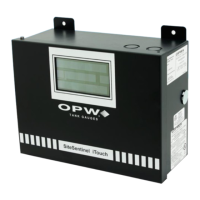To prevent the possibility of explosion or fire, do not test the sensor in the
Hazardous Area.
Work in a well-ventilated area with no hot surfaces or open flames.
Do not use fuel to test the sensor!
• Test the Sensor Portion.
o Put the polymer fully into mineral spirits for about 10 minutes
o Remove the sensor and let it hang to air dry
o After another 10 minutes any Controller alarms or events associated with the hydrocarbon sensor
should start
o Disconnect this part of the sensor from the Controller. An alarm should occur immediately.
o Short across these Controller positions. An alarm should occur.
o If the open lead and/or short lead test results are unsatisfactory, examine all wiring and junction
boxes for continuity.
• Test the Water Sensor Portion.
o Put just the end of the sensor fully in tap water. Controller alarms or events associated with the
water portion of the sensor should occur.
o Short the water portion of the sensor. An alarm should occur.
o If the short lead test result is unsatisfactory, examine all wiring and junction boxes for continuity
NOTE: If your controller does not sense the alarm conditions simulated here, examine your controller
thresholds to make sure they are correct.
• Clean the Hydrocarbon Sensor Portion. To clean hydrocarbon contamination (as a result of testing
or actual use) from the sensor:
o Put the contaminated portion fully into denatured alcohol for one hour
o Flush the sensor with water to remove any residue
o Allow the sensor to “settle” for another hour
NOTE: The sensor should return to near its original resistance, though it may be necessary to readjust the
controller’s thresholds.

